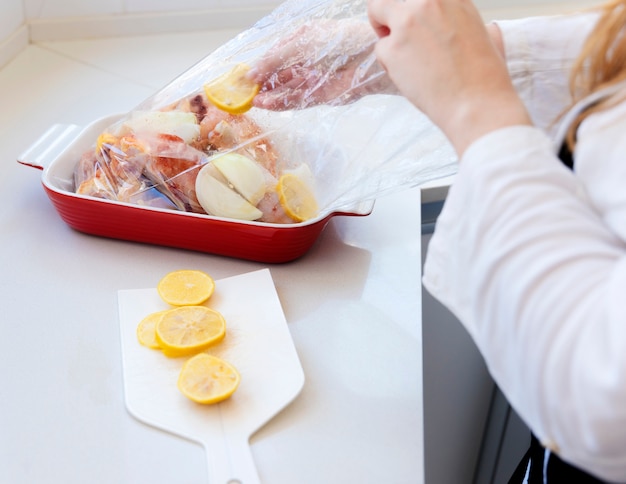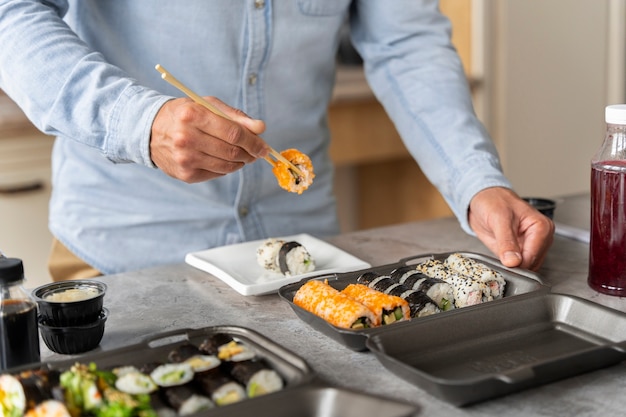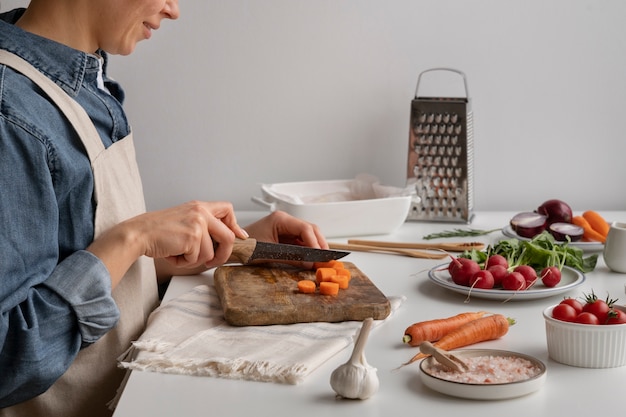Let’s be honest, cooking salmon on a Traeger can seem a bit intimidating at first. You’ve got the temperature to consider, the cooking time to guesstimate, and then there’s that whole wood-fired smoking thing! But trust me, once you get the hang of it, Traeger salmon becomes a go-to weeknight dinner, perfect for impressing guests or just treating yourself to something truly special.
The real beauty of cooking salmon on a Traeger lies in the smoky flavour. That rich, aromatic smoke infuses the fish, creating a depth of taste that’s simply unbeatable. It’s the difference between a simple salmon dinner and a culinary masterpiece. So, if you’re looking to elevate your fish game, let's dive into the world of Traeger salmon, and I’ll guide you through every step of the way.
(Part 1) Why Choose a Traeger for Your Salmon?

You might be thinking, “Why go through the hassle of firing up the Traeger when I can just bake it in the oven?” And it’s a valid question! However, there’s a certain magic that happens when you cook salmon on a Traeger, and it’s all about that smoky flavour.
The Smoke Factor
As I said before, the Traeger’s wood-fired flavour elevates salmon to a whole new level. It adds a depth and complexity that simply can’t be achieved with traditional oven baking. Imagine that delicious, smoky aroma wafting through your kitchen, and then that same smoky essence permeating every bite of your salmon. It’s truly a sensory experience.
Traeger Versatility
Another fantastic aspect of the Traeger is its versatility. It's not just for salmon! You can grill everything from chicken and steak to veggies and even pizza. It's like having a mini smoker in your backyard, perfect for creating all sorts of delicious, smoky dishes.
(Part 2) choosing the right salmon

The first step in cooking perfect Traeger salmon is choosing the right piece of fish. This might seem obvious, but there are a few things to keep in mind.
Skin On or Skin Off?
Personally, I'm a big fan of skin-on salmon. It helps retain moisture during cooking, and it adds a lovely crispy texture. However, if you’re not a fan of the skin or if you’re cooking for kids, skinless salmon is perfectly fine. The choice is yours!
Fresh or Frozen?
Fresh salmon is always the ideal choice. But if you’re working with frozen, make sure to thaw it thoroughly before cooking. You can do this by transferring it to the fridge overnight, or by using the defrost setting on your microwave. Just remember to pat it dry once it’s thawed.
Salmon Size
When it comes to Traeger salmon, you want a piece that’s thick enough to hold its shape, but not so large that it takes ages to cook. I typically go for a 1-inch thick fillet or a 2-pound whole salmon. This size allows for even cooking and a good ratio of cooked salmon to skin.
(Part 3) Preparing the Salmon for Traeger Cooking

Now that you’ve got your salmon chosen, it’s time to prepare it for its Traeger adventure. Here's where things get really interesting.
Brining for Maximum Moisture
One of my favorite tricks for cooking perfectly moist and flavorful salmon on the Traeger is to brine it. Brining involves soaking the salmon in a salt, sugar, and water solution, which draws moisture into the fish’s cells. The result? A juicy, tender salmon that’s practically bursting with flavour.
To brine your salmon, simply mix a brine solution (you’ll find countless recipes online). Then, submerge your salmon in the brine for 30 minutes to an hour. Once it’s brined, pat the salmon dry with paper towels. This is important because you want that skin to get nice and crispy.
Seasoning Your Salmon for Smoky Delight
The beauty of cooking salmon on a Traeger is that you don’t need to go overboard with seasoning. The smoky flavour will do most of the work. I typically stick to a simple blend of salt, pepper, and a pinch of lemon zest. You can also experiment with herbs like dill or thyme, but don’t overdo it. The star of the show is that smoky flavour.
(Part 4) Setting Up Your Traeger for Salmon
Now it’s time to get your Traeger ready for action. You want to make sure it's preheated and ready to infuse your salmon with that wonderful smoky goodness.
Preheat for Even Cooking
Before you even think about putting the salmon on the Traeger, preheat it to 350 degrees fahrenheit (175 degrees Celsius). This ensures that your salmon cooks evenly and gets that beautiful smoky flavour throughout.
Choosing the Right Wood
The type of wood you use will have a big impact on the flavour of your salmon. I’ve found that alder or applewood chips create a mild, slightly sweet smoke that complements salmon beautifully. However, you can experiment with different wood types like hickory or maple, depending on the flavour you’re aiming for.
Just remember to soak your wood chips in water for 30 minutes before adding them to your Traeger. This will help them smolder slowly and release that delicious smoke for longer.
(Part 5) Traeger Salmon Cooking Time at 350 Degrees
Now, for the moment of truth: the cooking time. Remember, the exact cooking time will vary depending on the thickness of your salmon fillet. Here’s a general guide to get you started:
| salmon thickness | Cooking Time |
|---|---|
| 1-inch thick fillet | 15-20 minutes |
| 2-inch thick fillet | 20-25 minutes |
| Whole salmon (2-3 pounds) | 30-40 minutes |
These are just estimates. The key is to check the internal temperature of your salmon. Use a meat thermometer to ensure it reaches an internal temperature of 145 degrees Fahrenheit (63 degrees Celsius). This ensures that the salmon is cooked through and safe to eat.
Avoiding overcooked salmon
One of the biggest mistakes people make when cooking salmon is overcooking it. Salmon is delicate and can dry out quickly if cooked for too long. That’s why checking the internal temperature with a meat thermometer is so important. It’s also a good idea to keep a close eye on your salmon as it cooks.
You’re looking for a salmon that is cooked through but still juicy and flaky. The flesh should be opaque, but not dry or rubbery.
(Part 6) The Flip – When and How
You’ll only need to flip your salmon once, and that’s when it’s about halfway cooked. You’ll know it’s time to flip when the flesh is opaque and slightly firm to the touch.
When you flip, be gentle! The skin can be delicate. Use a spatula to gently lift the salmon from the grill and flip it over carefully.
(Part 7) The Finish – Checking for Doneness and Resting
Once your salmon is cooked through, remove it from the Traeger and let it rest for 5-10 minutes. This allows the fish to continue cooking slightly and for the juices to redistribute, making it even more tender and flavorful.
Checking for Doneness
When it’s time to check for doneness, gently press the flesh with a fork. It should flake easily and not be translucent. It should also be cooked through, with an internal temperature of 145 degrees Fahrenheit (63 degrees Celsius).
(Part 8) Serving and Enjoying Your Traeger Salmon
And there you have it! Your delicious, smoky Traeger salmon is ready. Now, it’s time to get creative with your serving options.
Serving Suggestions
Traeger salmon is fantastic on its own, but it pairs beautifully with a variety of sides and toppings. Here are a few ideas to get you started:
- Roasted vegetables: roasted asparagus, Brussels sprouts, or broccoli are all delicious companions for smoky salmon.
- Light salad: A simple salad with mixed greens, a light vinaigrette, and maybe some toasted nuts or seeds will balance out the richness of the salmon.
- Creamy risotto: A creamy risotto with Parmesan cheese and a touch of lemon is a perfect match for the smoky flavour of your salmon.
- Sauces and toppings: Experiment with different sauces and toppings to enhance the flavour of your salmon. Lemon butter sauce, mango salsa, or a sprinkle of fresh herbs are all great options.
(Part 9) FAQs about Traeger Salmon
Here are some of the most common questions I get about cooking salmon on a Traeger:
1. Can I cook salmon on the Traeger in foil?
You can certainly cook salmon in foil on the Traeger, but it will lose that beautiful smoky flavour. If you want a more intense smoky taste, grill it directly on the grill.
2. How do I keep my salmon from sticking to the grill?
The best way to prevent sticking is to make sure the Traeger is preheated to a high enough temperature and to oil the grill grates lightly before placing the salmon on them.
3. How can I make sure my salmon doesn't dry out?
The key is to not overcook it! Use a meat thermometer to check for doneness and take the salmon off the Traeger as soon as it reaches 145 degrees Fahrenheit. Brining before cooking also helps retain moisture.
4. What if I overcook my salmon?
If you overcook your salmon, it will become dry and rubbery. There’s not much you can do to salvage it, but try serving it with a creamy sauce or topping to help mask the dryness.
5. Can I cook different types of fish on my Traeger?
Absolutely! You can cook a variety of fish on your Traeger, including tuna, trout, halibut, and even cod. Just adjust the cooking time depending on the thickness of the fish.
Well, there you have it! Hopefully, this guide has given you all the information you need to cook delicious and perfectly cooked salmon on your Traeger. Just remember, practice makes perfect, and don’t be afraid to experiment with different seasonings and techniques. Enjoy!
Everyone is watching

Prime Rib Roast Cooking Time Chart: Per Pound Guide
Cooking TipsPrime rib roast. Just the name conjures images of lavish dinners, crackling fires, and hearty laughter. It’s ...

How Long to Bake Potatoes in the Oven (Perfect Every Time)
Cooking TipsBaked potatoes are a staple in my kitchen. They're incredibly versatile, delicious, and surprisingly easy to m...

Perfect Rice Every Time: The Ultimate Guide to Cooking Rice
Cooking TipsAs a self-proclaimed foodie, I've always been a bit obsessed with rice. It's the foundation of countless cuisi...

The Ultimate Guide to Cooking Asparagus: Tips, Techniques, and Recipes
Cooking TipsAsparagus. The mere mention of this spring delicacy conjures up images of vibrant green spears, crisp and burs...

Ultimate Guide to Cooking the Perfect Thanksgiving Turkey
Cooking TipsThanksgiving. Just the word conjures up images of overflowing tables laden with delicious food, the scent of r...
